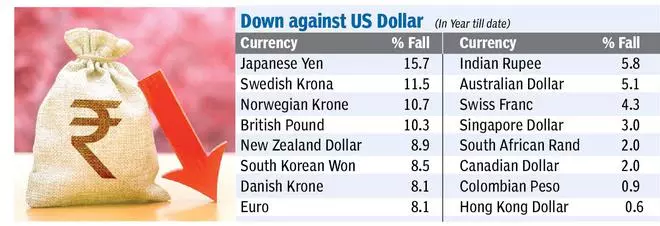Indian rupee (INR) has lost around 6 per cent against US dollar in the calendar year till date. However, there are still eight major economies including the UK, Japan and European Union, whose currencies have recorded bigger fall against USD in the current year.
The rupee, fter breaching level of 80 for a short while on Thursday, recovered a bit on Friday and settled at 79.91, 8 paise better than all-time low of 79.99. Various data points suggest Indian economy to see better days in short to medium term which will have positive impact on rupee.
Here are some key data. Merchandise exports rose by 16.8 per cent year-on-year to $37.94 billion in June this year from $32.49 billion in June 2021. India‘s Index of Eight Core Industries increased by 18.1 per cent in May.

Rising from 58.9 in May to 59.2 in June, the Services PMI was at its highest mark since April 2011 and signalled a steep rate of increase. Posting 53.9 in June, the Manufacturing PMI signalled a twelfth consecutive monthly improvement in the health of the sector. For the first time ever, the value of UPI transactions crossed the ₹10-lakh crore mark in Maycoming in at ₹10.4-lakh crore. It was at ₹10.14-lakh crore in June.
Rising capex in the public sector may have also begun to crowd-in private investment as seen in preliminary data collated for Q1 of 2022-23. In this quarter, the share of the Indian private sector in total investment proposals reached a record 85 per cent, rising from an average of 63 per cent in the preceding four quarters.
India has jumped six positions to 37th rank on the annual World Competitiveness Index compiled by the Switzerland-based Institute of Management Development (IMD) for the year 2022 on the back of better economic performance. This is expected to boost foreign investment.
Efforts of Govt, RBI
At the same time, the Union government in association with the Reserve Bank of India (RBI) is taking steps to rein in current account deficit (CAD). The government in early July imposed a windfall tax on domestic crude oil producers, imposed export duties on petrol, diesel and aviation turbine fuel (ATF), and hiked the import duty on gold in efforts to reduce pressure on the rupee, rein in the current account deficit (CAD), and increase the domestic supply of petroleum products.
There is feeling among experts that both government and RBI have provided dollar liquidity, and allowed for a gradual adjustment, while not losing sight of their policy commitments. In the near term, the focus is on providing liquidity, and ensuring there are no sharp moves.
Also, since India has had a strong recovery post pandemic, the surge in demand too is something that is leading to some incremental pressures on the import bill. But over time, if global commodity prices remain elevated, India needs to contend with the prospect of a larger current account deficit, which would mean that other macro variables have to adjust to this new global reality.
India’s exports too have hit all-time highs, and over time, as India’s ambitions to be a reliable and resilient exporting nation is realised, expectation is that India’s external position will be stabilised.








Comments
Comments have to be in English, and in full sentences. They cannot be abusive or personal. Please abide by our community guidelines for posting your comments.
We have migrated to a new commenting platform. If you are already a registered user of TheHindu Businessline and logged in, you may continue to engage with our articles. If you do not have an account please register and login to post comments. Users can access their older comments by logging into their accounts on Vuukle.